When we model a physical system by means of differential
equations, it is not generally possible to take into
account all the causes which determine the evolution. In
other words, we have to admit that there are small
perturbations acting on the vector fields of the
differential system which can not be accurately estimated,
consequently the validity of the description of the
evolution as given by the flow of the differential system
needs to be examined. In this section, we address the
question of how the qualitative behaviour of the system
To make the concept of structural stability precise, we need to define a norm of f.
Let
![]() ,
,
![]() is an open set, then the C1-norm of f on
is an open set, then the C1-norm of f on
![]() is defined by
is defined by

Definition 4.5.1: Let
![]() .
Then system (4.27) is said to be structurally stable
if there exists an
.
Then system (4.27) is said to be structurally stable
if there exists an ![]() such that for all
such that for all
![]() with
with
Example 4.5.1: Consider the linear system
 ,
,
 and
and
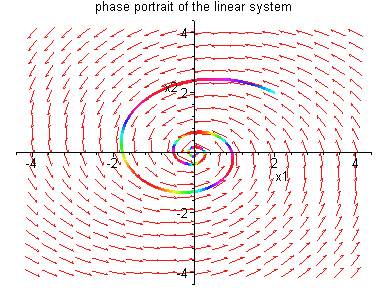
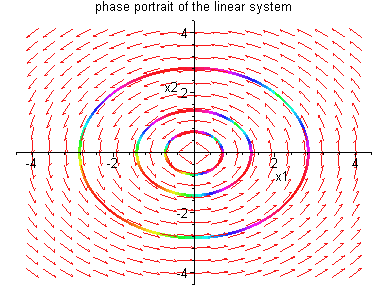
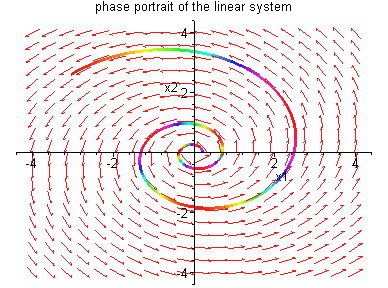
As in Example 4.5.1, differential equations that model
physical systems often contain parameters which may not be
known with great accuracy. Thus one wants to know whether
changes in the values of the parameters will cause
qualitative changes in the asymptotic behaviour of the
physical system. In system (4.31) of Example 4.5.1, the
parameter ![]() changes from
changes from ![]() to
to
![]() and results in qualitative changes in the
long term behaviour of solutions. The number
and results in qualitative changes in the
long term behaviour of solutions. The number ![]() is called a bifurcation value for system (4.31). A
formal definition is given below
is called a bifurcation value for system (4.31). A
formal definition is given below
Consider the system
Definition 4.5.2: A value ![]() of
system (4.33) for which it is not structurally stable is
called a bifurcation value of
of
system (4.33) for which it is not structurally stable is
called a bifurcation value of ![]() .
.
The simplest bifurcations are those for which the lack of structural stability is due to the presence of a non-hyperbolic equilibrium point. Here are some examples.
Example 4.5.2: Consider the one-dimensional
system
For ![]() ,
there is only one equilibrium point
x = 0,
Df(0,0) = 0. For
,
there is only one equilibrium point
x = 0,
Df(0,0) = 0. For ![]() ,
there is
no equilibrium point.
,
there is
no equilibrium point.
Thus ![]() is a bifurcation value since the
differential equation
x' = -x2 is not
structurally stable. The phase portraits and the
bifurcation diagram are given below.
is a bifurcation value since the
differential equation
x' = -x2 is not
structurally stable. The phase portraits and the
bifurcation diagram are given below.

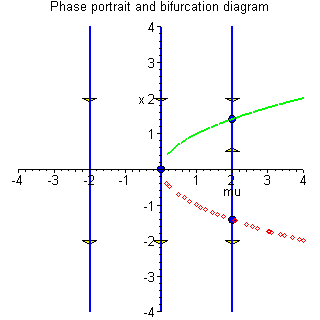
This type of bifurcation is called a saddle-node
bifurcation.
Example 4.5.3: Consider the one-dimensional
system

This type of bifurcation is called transcritical bifurcation.
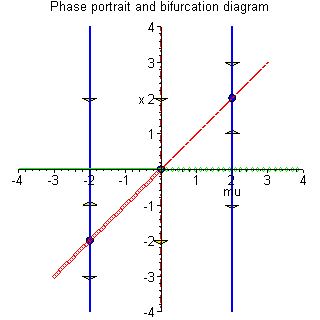
Example 4.5.4: Consider the one-dimensional
system
For ![]() ,
there is only one equilibrium point
x = 0 which is non-hyperbolic since
Df (0,0) =
0.
,
there is only one equilibrium point
x = 0 which is non-hyperbolic since
Df (0,0) =
0.
For ![]() ,
there is only one equilibrium point
x = 0.
,
there is only one equilibrium point
x = 0.
![]() .
Thus x = 0 is
asymptotically stable. Thus
.
Thus x = 0 is
asymptotically stable. Thus ![]() is a
bifurcation value. The phase portraits and bifurcation
diagram are shown below.
is a
bifurcation value. The phase portraits and bifurcation
diagram are shown below.

This type of bifurcation is called a pitchfork bifurcation.
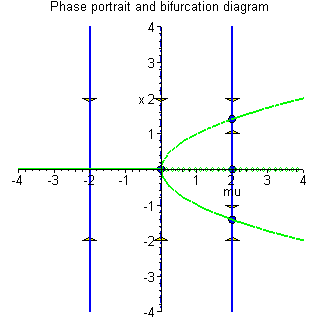
It should be noted that an equilibrium point is non-hyperbolic is a necessary but not sufficient condition for bifurcation to occur.
Example 4.5.5: Consider the one-dimensional
system
